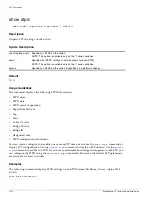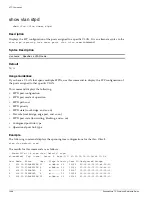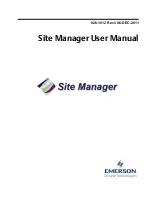
ExtremeWare 7.5 Command Reference Guide
1483
18
ESRP Commands
This chapter describes the following commands:
•
Commands for enabling and disabling ESRP
•
Commands for performing basic ESRP configuration
•
Commands for enabling and disabling port restart and failure tracking for ESRP
•
Commands for displaying ESRP configuration information
•
Commands for enabling and disabling ELRP in an ESRP environment
•
Commands for enabling, disabling, configuring, and monitoring the Extreme Link Status Monitoring
(ELSM) protocol
ESRP is a feature of ExtremeWare that allows multiple switches to provide redundant layer 3 routing
services to users. In addition to providing layer 3 routing redundancy, ESRP also provides for layer 2
redundancy. These “layered” redundancy features can be used in combination or independently. The
layer 2 redundancy features of ESRP offer fast failure recovery and provide for dual-homed system
design. In some instances, depending on network system design, ESRP can provide better resiliency
than using the Spanning Tree Protocol (STP) or Virtual Router Redundancy Protocol (VRRP).
Extreme switches that are not running ESRP, but are connected on a network that has other Extreme
switches running ESRP are ESRP-
aware
. This means that when Extreme switches are attached to the
ESRP-enabled switches, the non-ESRP switches reliably perform fail-over and fail-back scenarios in the
prescribed recovery times. No configuration of this feature is necessary.
NOTE
If you disable EDP on the switch, the switch is no longer ESRP-aware.
ESRP is configured on a per-VLAN basis on each switch. A maximum of four switches can participate
in providing redundant layer 3 or layer 2 services to a single VLAN. The switches exchange keep-alive
packets for each VLAN independently. Only one switch can actively provide layer 3 routing and/or
layer 2 switching for each VLAN. The switch performing the forwarding for a particular VLAN is
considered the “master” for that VLAN. Other participating switches for the VLAN are in slave mode.
To have two or more switches participate in ESRP, the following must be true:
•
For each VLAN to be made redundant, the switches must have the ability to exchange packets on
the same layer 2 broadcast domain for that VLAN. Multiple paths of exchange can be used.
Summary of Contents for ExtremeWare 7.5
Page 402: ...402 ExtremeWare 7 5 Command Reference Guide VLAN Commands ...
Page 470: ...470 ExtremeWare 7 5 Command Reference Guide QoS Commands ...
Page 490: ...490 ExtremeWare 7 5 Command Reference Guide NAT Commands ...
Page 826: ...826 ExtremeWare 7 5 Command Reference Guide Commands for Status Monitoring and Statistics ...
Page 1090: ...1090 ExtremeWare 7 5 Command Reference Guide Security Commands ...
Page 1386: ...1386 ExtremeWare 7 5 Command Reference Guide Wireless Commands ...
Page 1436: ...1436 ExtremeWare 7 5 Command Reference Guide EAPS Commands ...
Page 1568: ...1568 ExtremeWare 7 5 Command Reference Guide ESRP Commands ...
Page 1844: ...1844 ExtremeWare 7 5 Command Reference Guide IGP Commands ...
Page 1930: ...1930 ExtremeWare 7 5 Command Reference Guide BGP Commands i Series Switches Only ...
Page 2022: ...2022 ExtremeWare 7 5 Command Reference Guide IP Multicast Commands ...
Page 2066: ...2066 ExtremeWare 7 5 Command Reference Guide IPX Commands i Series Platforms Only ...
Page 2082: ...2082 ExtremeWare 7 5 Command Reference Guide ARM Commands BlackDiamond Switch Only ...
Page 2094: ...2094 ExtremeWare 7 5 Command Reference Guide Remote Connect Commands ...
Page 2174: ...2174 ExtremeWare 7 5 Command Reference Guide PoS Commands BlackDiamond Switch Only ...
Page 2372: ...2372 ExtremeWare 7 5 Command Reference Guide LLDP Commands ...
Page 2422: ...2422 ExtremeWare 7 5 Command Reference Guide H VPLS Commands BlackDiamond Switch Only ...
Page 2528: ...2528 ExtremeWare 7 5 Command Reference Guide MPLS Commands BlackDiamond Switch Only ...
















































